This was published 9 months ago
Trump-era Pentagon ran secret anti-vax social media campaign aimed at the Philippines
By Christopher Bing and Joel Schectman
Washington: At the height of the COVID-19 pandemic, the US military launched a secret campaign to counter what it perceived as China’s growing influence in the Philippines, a nation hit especially hard by the deadly virus.
The clandestine operation, which has not been previously reported, aimed to sow doubt about the safety and efficacy of vaccines and other life-saving aid that was being supplied by China, a Reuters investigation found.
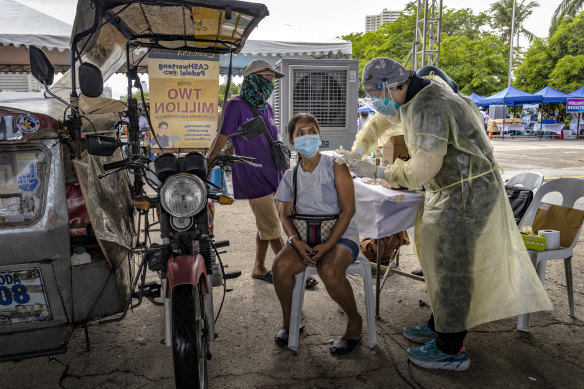
A public transportation worker is inoculated with Sinovac Biotech’s COVID-19 vaccine in Manila in 2021.Credit: Getty Images
Through phony internet accounts meant to impersonate Filipinos, the American military’s propaganda efforts morphed into an anti-vax campaign. Social media posts decried the quality of face masks, test kits and the first vaccine that would become available in the Philippines: China’s Sinovac inoculation.
Reuters identified at least 300 accounts on X, formerly Twitter, that matched descriptions shared by former US military officials familiar with the operation in the Philippines. Almost all were created in the northern summer of 2020 and centred on the slogan #Chinaangvirus – Tagalog for “China is the virus”.
The phony accounts used by the US military had tens of thousands of followers during the program, in a country with a population of 114 million.
“COVID came from China and the VACCINE also came from China, don’t trust China!” one typical tweet from July 2020 read in Tagalog. The words were next to a photo of a syringe beside a Chinese flag and a soaring chart of infections. Another post read: “From China – PPE, Face Mask, Vaccine: FAKE. But the Coronavirus is real.”
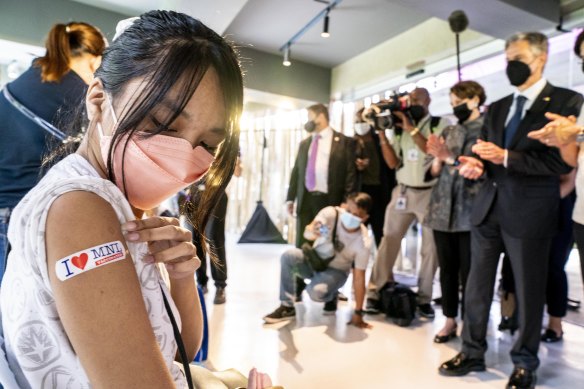
US Secretary of State Antony Blinken (right) applauds as Gabrielle Cubacub, 15 (left), gets a COVID-19 vaccination in Manila this month.Credit: AP
After Reuters asked X about the accounts, the social media company removed the profiles, and determined they were part of a co-ordinated bot campaign based on activity patterns and internal data.
The US military’s anti-vax effort began in the northern spring of 2020 and expanded beyond South-East Asia before it was terminated in mid-2021, Reuters determined. Tailoring the propaganda campaign to audiences across central Asia and the Middle East, the Pentagon used a combination of fake social media accounts on multiple platforms to spread fear of China’s vaccines among Muslims at a time when the virus was killing tens of thousands of people daily. A key part of the strategy was to amplify the disputed contention that because vaccines sometimes contain pork gelatin, China’s shots could be considered forbidden under Islamic law.
The military program started under then-president Donald Trump and continued months into Joe Biden’s presidency, Reuters found – even after alarmed social media executives warned the new administration that the Pentagon was trafficking COVID-19 misinformation. The Biden White House issued an edict in spring 2021 banning the anti-vax effort, which also disparaged vaccines produced by other rivals, and the Pentagon initiated an internal review, Reuters found.
The US military is prohibited from targeting Americans with propaganda, and Reuters found no evidence the Pentagon’s influence operation did so.
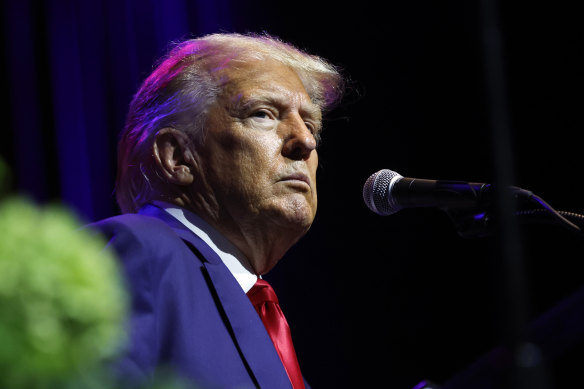
As president, Donald Trump called COVID-19 the “China virus”.Credit: AP
Spokespeople for Trump and Biden did not respond to requests for comment about the clandestine program.
A senior Defence Department official acknowledged the US military had engaged in secret propaganda to disparage China’s vaccine in the developing world, but the official declined to provide details.
A Pentagon spokeswoman said the US military “uses a variety of platforms, including social media, to counter those malign influence attacks aimed at the US, allies, and partners”. She also said that China had started a “disinformation campaign to falsely blame the United States for the spread of COVID-19”.
In an email, the Chinese Ministry of Foreign Affairs said that it had long maintained the US government manipulated social media and spread misinformation.
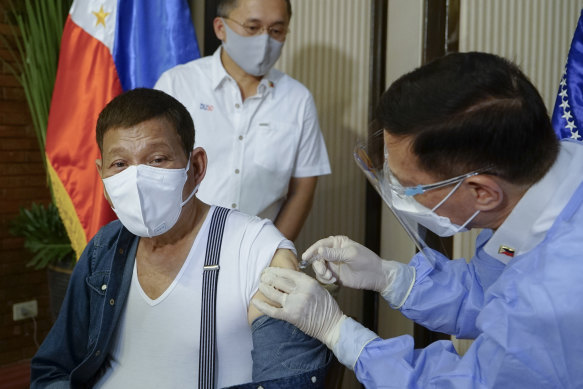
In 2021, then-Philippine president Rodrigo Duterte received his second dose of the Sinopharm vaccine.Credit: Malacanang Presidential Photographers Division
Manila’s embassy in Washington did not respond to Reuters inquiries, including whether it had been aware of the Pentagon operation. A spokesperson for the Philippines Department of Health, however, said the “findings by Reuters deserve to be investigated and heard by the appropriate authorities of the involved countries”. Some aid workers in the Philippines, when told of the US military propaganda effort by Reuters, expressed outrage.
Briefed on the Pentagon’s secret anti-vax campaign by Reuters, some American public health experts also condemned the program, saying it put civilians in jeopardy for potential geopolitical gain. An operation meant to win hearts and minds had endangered lives, they said.
“I don’t think it’s defensible,” said Daniel Lucey, an infectious disease specialist at Dartmouth’s Geisel School of Medicine. “I’m extremely dismayed, disappointed and disillusioned to hear that the US government would do that.” Lucey is a former military physician who assisted in the response to the 2001 anthrax attacks.
The effort to stoke fear about Chinese inoculations risked undermining overall public trust in government health initiatives, including US-made vaccines that became available later, Lucey and others said. Although the Chinese vaccines were found to be less effective than the American-led shots made by Pfizer and Moderna, all were approved by the World Health Organisation. Sinovac did not respond to a request for comment.
‘I don’t think it’s defensible. I’m extremely dismayed, disappointed and disillusioned to hear that the US government would do that.’
Daniel Lucey, an American infectious disease specialist
Academic research published recently has shown that when individuals develop scepticism towards a single vaccine, those doubts often lead to uncertainty about other inoculations. Lucey and other health experts say they saw such a scenario play out in Pakistan, where the Central Intelligence Agency used a fake hepatitis vaccination program in Abbottabad as cover to hunt for Osama bin Laden, the terrorist mastermind behind the September 11, 2001 attacks. Discovery of the ruse led to a backlash against an unrelated polio vaccination campaign, including attacks on healthcare workers, and that contributed to the re-emergence of the deadly disease in Pakistan.
“It should have been in our interest to get as much vaccine in people’s arms as possible,” said Greg Treverton, former chairman of the US National Intelligence Council, which co-ordinates the analysis and strategy of Washington’s many spy agencies. What the Pentagon did, Treverton said, “crosses a line”.
‘We were desperate’
Reuters could not determine how widely the anti-vax material and other Pentagon-planted disinformation was viewed, or to what extent the posts may have caused COVID-19 deaths by dissuading people from getting vaccinated.
In the wake of the US propaganda efforts, however, then-Philippine president Rodrigo Duterte had grown so dismayed by how few Filipinos were willing to be inoculated that he threatened to arrest people who refused vaccinations.
“You choose, vaccine or I will have you jailed,” a masked Duterte said in a televised address in June 2021. “There is a crisis in this country … I’m just exasperated by Filipinos not heeding the government.”
When he addressed the vaccination issue, the Philippines had among the worst inoculation rates in South-East Asia. Only 2.1 million of the country’s 114 million citizens were fully vaccinated – far short of the government’s target of 70 million. By the time Duterte spoke, COVID-19 cases exceeded 1.3 million, and almost 24,000 Filipinos had died from the virus. The difficulty in vaccinating the population contributed to the worst death rate in the region.
A spokesperson for Duterte did not make the former president available for an interview.
Some Philippine healthcare professionals and former officials contacted by Reuters were shocked by the US anti-vax effort, which they say exploited an already vulnerable citizenry. Public concerns about a dengue fever vaccine, rolled out in the Philippines in 2016, had led to broad scepticism towards inoculations overall, said Lulu Bravo, the executive director of the Philippine Foundation for Vaccination. The Pentagon campaign preyed on those fears.
“Why did you do it when people were dying? We were desperate,” said Dr Nina Castillo-Carandang, a former adviser to the World Health Organisation and the Philippine government during the pandemic. “We don’t have our own vaccine capacity,” she noted, and the US propaganda effort “contributed even more salt into the wound”.
The campaign also reinforced what one former health secretary called a long-standing suspicion of China, most recently because of aggressive behaviour by Beijing in disputed areas of the South China Sea.
Filipinos were unwilling to trust China’s Sinovac, which first became available in the country in March 2021, said Esperanza Cabral, who served as health secretary under Gloria Macapagal Arroyo when she was president. Cabral said she was unaware of the US military’s secret operation.
‘We weren’t looking at this from a public health perspective. We were looking at how we could drag China through the mud.’
A senior US military officer involved in the program
“I’m sure that there are lots of people who died from COVID who did not need to die from COVID,” she said.
To implement the anti-vax campaign, the US Defence Department overrode strong objections from top American diplomats in South-East Asia at the time, Reuters found. Sources involved in its planning and execution say the Pentagon, which ran the program through the military’s psychological operations centre in Tampa, Florida, disregarded the collateral impact that such propaganda might have on innocent Filipinos.
“We weren’t looking at this from a public health perspective,” said a senior military officer involved in the program. “We were looking at how we could drag China through the mud.”
Disinformation war
In uncovering the secret US military operation, Reuters interviewed more than two dozen current and former US officials, military contractors, social media analysts and academic researchers. Reporters also reviewed Facebook, X and Instagram posts, technical data and documents about a set of fake social media accounts used by the US military. Some were active for more than five years.
Clandestine psychological operations are among the government’s most highly sensitive programs. Knowledge of their existence is limited to a small group of people within US intelligence and military agencies. Such programs are treated with special caution because their exposure could damage foreign alliances or escalate conflict with rivals.
Over the past decade, some US national security officials have pushed for a return to the kind of aggressive clandestine propaganda operations against rivals that the US wielded during the Cold War. Following the 2016 US presidential election, in which Russia used a combination of hacks and leaks to influence voters, the calls to fight back grew louder in Washington.
In 2019, Trump authorised the CIA to launch a clandestine campaign on Chinese social media aimed at turning public opinion in China against its government, Reuters reported in March. As part of that effort, a small group of operatives used bogus online identities to spread disparaging narratives about Xi Jinping’s government.
COVID-19 galvanised the drive to wage psychological operations against China. One former senior Pentagon leader described the pandemic as a “bolt of energy” that finally ignited the long-delayed counter-offensive against China’s influence war.
The Pentagon’s anti-vax propaganda came in response to China’s own efforts to spread false information about the origins of COVID-19.
The virus first emerged in China in late 2019. But in March 2020, Chinese government officials claimed without evidence that the virus might have been first brought to China by an American service member who participated in an international military sports competition in Wuhan the previous year. Chinese officials also suggested that the virus may have originated in a US Army research facility at Fort Detrick, Maryland. There’s no evidence for that assertion.
Mirroring Beijing’s public statements, Chinese intelligence operatives set up networks of fake social media accounts to promote the Fort Detrick conspiracy, according to a US Justice Department complaint.
China’s messaging got Washington’s attention. Trump subsequently coined the term “China virus” as a response to Beijing’s accusation that the US military had exported COVID-19 to Wuhan.
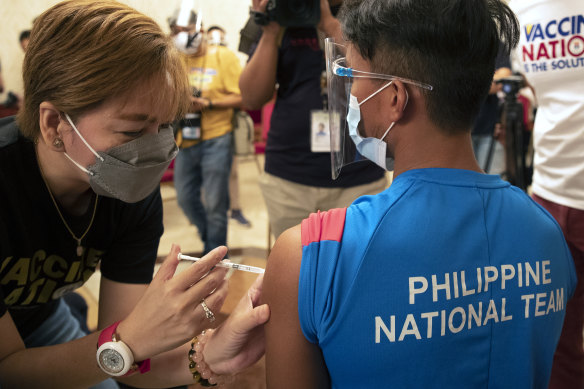
A Philippine athlete is inoculated with China’s Sinovac COVID-19 vaccine in Manila in 2021.Credit: AP
“That was false. And rather than having an argument, I said, ‘I have to call it where it came from’,” Trump said in a March 2020 news conference. “It did come from China.”
China’s Foreign Ministry said in an email that it opposed “actions to politicise the origins question and stigmatise China”. The ministry had no comment about the Justice Department’s complaint.
Beijing didn’t limit its global influence efforts to propaganda. It announced an ambitious COVID-19 assistance program, which included sending masks, ventilators and its own vaccines – still being tested at the time – to struggling countries.
In May 2020, Xi announced that the vaccine China was developing would be made available as a “global public good”, and would ensure “vaccine accessibility and affordability in developing countries”. Sinovac was the primary vaccine available in the Philippines for about a year until US-made vaccines became more widely available there in early 2022.
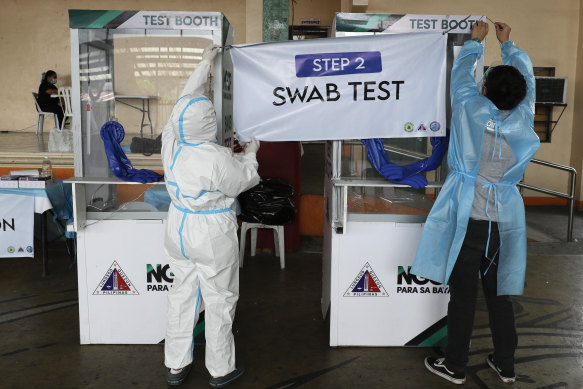
Health workers arrange a sign at a COVID-19 testing site in Quezon City, the Philippines in 2021.Credit: AP
Washington’s plan, called Operation Warp Speed, was different. It favoured inoculating Americans first, and it placed no restrictions on what pharmaceutical companies could charge developing countries for the remaining vaccines not used by the United States. The deal allowed the companies to “play hardball” with developing countries, forcing them to accept high prices, said Lawrence Gostin, a professor of medicine at Georgetown University who has worked with the World Health Organisation.
The deal “sucked most of the supply out of the global market”, Gostin said. “The United States took a very determined America-first approach.”
To Washington’s alarm, China’s offers of assistance were tilting the geopolitical playing field across the developing world, including in the Philippines, where Duterte’s government faced upwards of 100,000 infections in the early months of the pandemic.
The US relationship with Manila had grown tense after the 2016 election of the bombastic Duterte. A staunch critic of the US, he had threatened to cancel a key pact that allows the US military to maintain legal jurisdiction over American troops stationed in the country.
‘We didn’t do a good job sharing vaccines with partners. So what was left to us was to throw shade on China’s.’
A senior US military officer directly involved in the campaign in South-East Asia
Duterte said in a July 2020 speech he had made “a plea” to Xi that the Philippines be at the front of the line as China rolled out vaccines.
He vowed in the same speech that the Philippines would no longer challenge Beijing’s aggressive expansion in the South China Sea, a statement that upended a key security understanding Manila had long held with Washington.
“China is claiming it. We are claiming it. China has the arms, we do not have it,” Duterte said at the time. “So, it is simple as that.”
Days later, China’s foreign minister announced Beijing would grant Duterte’s plea for priority access to the vaccine, as part of a “new highlight in bilateral relations”.
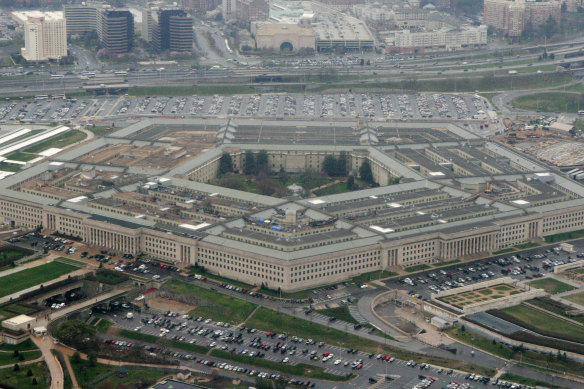
The Pentagon gave secret authorisation for the US to embark on the clandestine propaganda campaign against China.Credit: AP
China’s growing influence fuelled efforts by US military leaders to launch the secret propaganda operation Reuters uncovered.
“We didn’t do a good job sharing vaccines with partners,” a senior US military officer directly involved in the campaign in South-East Asia told Reuters. “So what was left to us was to throw shade on China’s.”
Military trumped diplomats
US military leaders feared that China’s COVID-19 diplomacy and propaganda could draw other South-East Asian countries, such as Cambodia and Malaysia, closer to Beijing, which would have furthered China’s regional ambitions.
A senior US military commander responsible for South-East Asia, Special Operations Command Pacific General Jonathan Braga, pressed his bosses in Washington to fight back in the so-called information space, according to three former Pentagon officials.
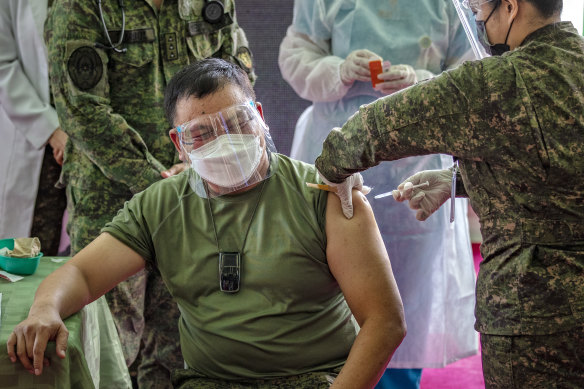
Philippine Army Commanding General Jose Faustino Jr is vaccinated with Sinovac Biotech’s vaccine in Fort Bonifacio in 2021.Credit: Getty Images
The commander initially wanted to punch back at Beijing in South-East Asia. The goal: to ensure the region understood the origin of COVID-19 while promoting scepticism towards what were then still-untested vaccines offered by a country that the US said had lied continually since the start of the pandemic.
A spokesperson for Special Operations Command declined to comment.
At least six senior State Department officials responsible for the region objected to this approach. A health crisis was the wrong time to instil fear or anger through a psychological operation, or “psyop”, they argued during Zoom calls with the Pentagon.
“We’re stooping lower than the Chinese, and we should not be doing that,” said a former senior State Department official for the region who fought against the military operation.
While the Pentagon saw Washington’s rapidly diminishing influence in the Philippines as a call to action, the withering partnership led American diplomats to plead for caution.
“The relationship is hanging from a thread,” another former senior US diplomat recounted. “Is this the moment you want to do a psyop in the Philippines? Is it worth the risk?”
In the past, such opposition from the State Department might have proved fatal to the program. Previously in peacetime, the Pentagon needed the approval of embassy officials before conducting psychological operations in a country, which often hamstrung commanders seeking to quickly respond to Beijing’s messaging, three former Pentagon officials told Reuters.
US propaganda machine
But in 2019, before COVID-19 surfaced in full force, then-secretary of Defence Mark Esper signed a secret order that later paved the way for the launch of the US military propaganda campaign. The order elevated the Pentagon’s competition with China and Russia to the priority of active combat, enabling commanders to sidestep the State Department when conducting psyops against those adversaries. The Pentagon spending bill passed by Congress that year also explicitly authorised the military to conduct clandestine influence operations against other countries, even “outside of areas of active hostilities”.
Esper, through a spokesperson, declined to comment. A State Department spokesperson referred questions to the Pentagon.
In the northern spring of 2020, special-ops commander Braga turned to a cadre of psychological-warfare soldiers and contractors in Tampa to counter Beijing’s COVID-19 efforts. Colleagues say Braga was a longtime advocate of increasing the use of propaganda operations in global competition. In trailers and squat buildings at a facility on Tampa’s MacDill Air Force Base, US military personnel and contractors used anonymous accounts on X, Facebook and other social media to spread what became an anti-vax message. The facility remains the Pentagon’s clandestine propaganda factory.
Psychological warfare has played a role in US military operations for more than 100 years, although it has changed in style and substance over time. So-called psyopers were best known following World War II for their supporting roles in combat missions across Vietnam, Korea and Kuwait, often dropping leaflets to confuse the enemy or encourage their surrender.
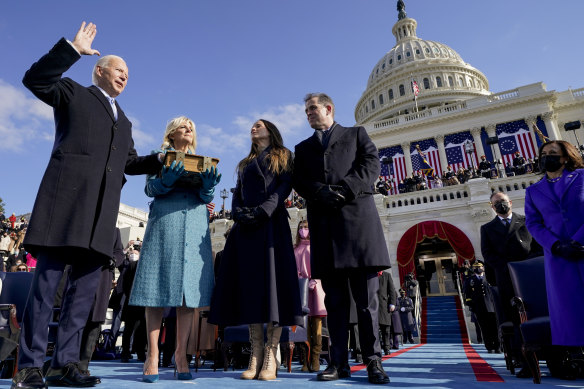
The secret US operation continued even after Joe Biden was sworn in as president in January 2021.Credit: AP
After the al-Qaeda attacks of 2001, the United States was fighting a borderless, shadowy enemy, and the Pentagon began waging a more ambitious kind of psychological combat previously associated only with the CIA. The Pentagon set up front news outlets, paid off prominent local figures, and sometimes funded television soap operas to turn local populations against militant groups or Iranian-backed militias, former national security officials told Reuters.
Unlike earlier psyop missions, which sought specific tactical advantage on the battlefield, the post-9/11 operations hoped to create broader change in public opinion across entire regions.
By 2010, the military began using social media tools, leveraging phony accounts to spread messages of sympathetic local voices – themselves often secretly paid by the United States government. As time passed, a growing web of military and intelligence contractors built online news websites to pump US-approved narratives into foreign countries. Today, the military employs a sprawling ecosystem of social media influencers, front groups and covertly placed digital advertisements to influence overseas audiences, according to current and former military officials.
One military-created meme targeting central Asia showed a pig made out of syringes, according to two people who viewed the image. Reuters found similar posts that traced back to US Central Command. One shows a Chinese flag as a curtain separating Muslim women in hijabs and pigs stuck with vaccine syringes. In the centre is a man with syringes; on his back is the word “China”. It targeted central Asia, including Kazakhstan, Kyrgyzstan and Uzbekistan, a country that distributed tens of millions of doses of China’s vaccines and participated in human trials. Translated into English, the X post reads: “China distributes a vaccine made of pork gelatin.”
Facebook executives first approached the Pentagon in the summer of 2020, warning the military that Facebook workers had easily identified the military’s phony accounts, according to three former US officials and another person familiar with the matter. The government, Facebook argued, was violating Facebook’s policies by operating the bogus accounts and by spreading COVID-19 misinformation.
The military argued that many of its fake accounts were being used for counter-terrorism and asked Facebook not to take down the content, according to two people familiar with the exchange. The Pentagon pledged to stop spreading COVID-related propaganda, and some of the accounts remained active on Facebook.
Nonetheless, the anti-vax campaign continued into 2021 as Biden took office.
Angered that military officials had ignored their warning, Facebook officials arranged a Zoom meeting with Biden’s new National Security Council shortly after the inauguration, Reuters learnt. The discussion quickly became tense.
“It was terrible,” said a senior administration official describing the reaction after learning of the campaign’s pig-related posts. “I was shocked. The administration was pro-vaccine and our concern was this could affect vaccine hesitancy, especially in developing countries.”
By spring 2021, the National Security Council ordered the military to stop all anti-vaccine messaging. “We were told we needed to be pro-vaccine, pro all vaccines,” said a former senior military officer who helped oversee the program.
Even so, Reuters found some anti-vax posts that continued through April and other deceptive COVID-related messaging that extended into that summer. Reuters could not determine why the campaign didn’t end immediately with the security council’s order. The council declined to comment.
The senior Defence Department official said that those complaints led to an internal review in late 2021, which uncovered the anti-vaccine operation. The probe also turned up other social and political messaging that was “many, many leagues away” from any acceptable military objective. The official would not elaborate.
The review intensified in 2022, the official said, after a group of academic researchers at Stanford University flagged some of the same accounts as pro-Western bots in a public report.
And in February, the contractor that worked on the anti-vax campaign – General Dynamics IT – won a $US493 million ($746 million) contract. Its mission: to continue providing clandestine influence services for the military.
Reuters
Get a note directly from our foreign correspondents on what’s making headlines around the world. Sign up for the weekly What in the World newsletter here.